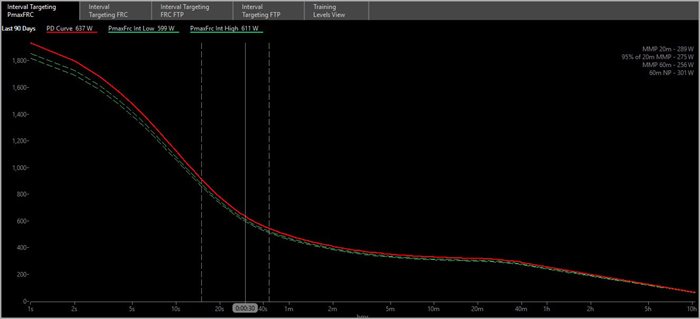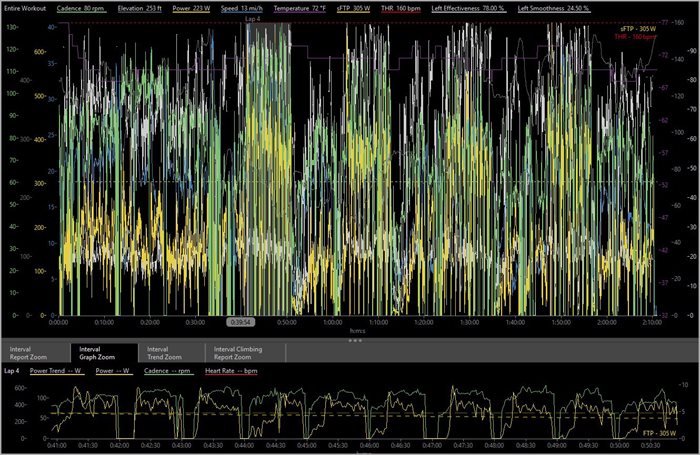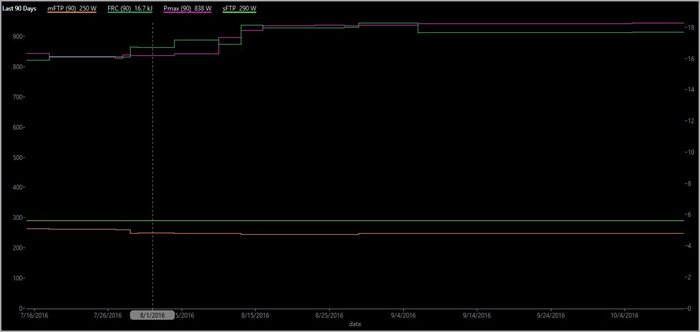Now that the cyclocross season is in high gear and with a lot of workouts and races under our belt, we are proving the importance of analyzing the right data and using WKO4 to help our athletes have their best cyclocross season yet.
How Hard is Enough?
After a long spring and summer of training and road racing, the data and information collected using WKO4 spanned all types of durations and intensities. However, as the cyclocross season approached, we eased our training levels away from the standard Functional Threshold Power (FTP) ranges and more towards the new pMax and Functional Reserve Capacity (FRC) metrics.
Although a high level of aerobic fitness is critical to perform well in cycling, at no time will there be twenty continuous minutes of pedaling in a cyclocross race. As such, there is no reason to base training zones on the standard “95 percent method” of FTP. Although this is a fantastic guideline for endurance and multisport athletes, the dynamic modern cyclocross rider needs event specific training to get the most out of race day.
Using pMax and FRC in WKO4
The short-term, high-end power and hard work performance shown by the pMax and FRC metrics are perfect for cyclocross. By using the Power Duration Interval Targeting charts and focusing on the Pmax/FRC curve, we can see the target ranges an athlete should aim for in order to help develop the appropriate race power.

For this athlete, we can see the target ranges for the old cyclocross stand-by “30/30s”, where an athlete hits the gas for 30 seconds and then recovers again equally. In the past, coaches would use the subjective “as hard as you can” description. Using the WKO4 Interval Targets we see this athlete should aim for between 599 and 611 watts. Ouch. It is up to the coach to decide, usually on upcoming race scenarios, whether to aim for the intensive (harder) side of the range or the extensive (longer) half of that target curve.
These same targeting charts can be used for all of the iLevel training zones and should be adapted based on the needs of the upcoming races, the athlete themselves, and whether the plan is calling for intensive or extensive training durations. Nothing makes the pain go away like crushing your competition.
How to Use the Lap Button
One of the questions we get from athletes is how often they should hit the lap or interval button on their bike computer during training sessions. Although having neatly labeled intervals is a coach’s dream for ride file review, we would rather have the rider concentrate on the effort of the interval and most importantly safety on the road.
When using WKO4 to review a workout we are searching for very specific time periods, power metrics, or energy usage trends, so it’s okay if every single sprint or effort isn’t demarcated. The coach can use the Right Hand Explorer (RHE) to look at “peaks” or custom determined time ranges. For instance, multiple sets of ten minute long micro intervals will be reviewed both by the peak short duration power and by the total overall physiological effect of the set, both of which are easily seen on the standardized time ranges.
Make Use of Couch Time
After a workout, an athlete and their coach should use WKO4 to properly analyze a training ride or cyclocross race. After drilling down to the individual ride using the Left Hand Explorer (LHE), there are a few workout level charts that we like to use to make sure that the training was done correctly and to determine what the athlete should do to continue to improve in the future.
First, analyze at the Horizontal Cycling Interval Review workout chart to see if the training was done correctly: specifically the duration and level of the efforts. This sounds overly obvious, but as we mentioned above, we want to make sure that the right energy systems are being utilized during training so as to get the maximum effect on race day.

Here we can see a ride from an athlete who was doing a hard workout with minimal recovery to develop both that intense power and muscular endurance needed for cyclocross. Although the chart looks very busy, it’s easy to see the expected repeated hard efforts and recovery so at least we know the athlete tried. We can then drill down to two different important time frames (for this particular type of workout): the individual short effort duration (30 seconds) and the overall power for the set of efforts (10 minutes). Both of those levels are important because we want to make sure that each effort was hitting the required height and that the rider was getting the overall training effect.
We also like to review the Crank Torque chart to make sure that the athlete is learning to hit the gas properly at the start of these short, hard efforts. Anyone who has done a race knows how critical it is to have the starting power to jump out of a corner, attack a flyover or remount after a hurdle in a monster gear. Just the thought of it gives a coach the chills.

With this chart we can see the short sharp spikes in crank torque that indicate that the rider was doing the workout properly, with some being better than others. This provides great feedback to discuss with the athlete to help them repeat that effort on race day. Whether it’s a bigger gear, better hand position, or stronger core activation, practice makes perfect.
Think Big Picture
One of the final charts in WKO4 that we like to review during the cyclocross season is at the athlete level on the Power Duration History Metrics chart from the Power Duration Curve pack. This is a great way to track the progress of season critical metrics like pMax and FRC in an easily visible and tangible view. On the chart below we can see how one of our female athletes has improved leading into this year’s season and continues to stay strong.

Paradigm Shift
We switched to exclusively using WKO4 to analyze and help us plan the training for our cyclocross riders. Taking full advantage of all it has to offer has really helped us coach our athletes to their best seasons ever. Here at Finish Fast Cycling we are thrilled to see how well everyone has performed.

